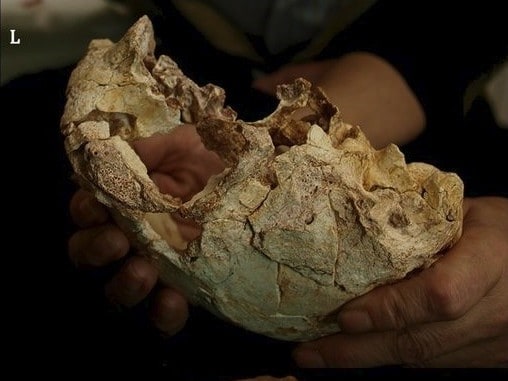
 A team of archaeologists has unearthed a 400,000 year-old skull from a cave in Portugal which bears a strange mix of traits, some related to Neanderthals with others closer to Home erectus.
A team of archaeologists has unearthed a 400,000 year-old skull from a cave in Portugal which bears a strange mix of traits, some related to Neanderthals with others closer to Home erectus.
Experts say that evidence of this new Mystery Man might change our way of thinking about human evolution, arguing that there may have been more variation within hominin species than previously assumed.
“There is a lot of debate currently in the anthropological literature about what species to call these fossils,” says Rolf Quam from New York’s Binghamton University, co-author of the new study. “There is not a lot of agreement.”
The new discovery includes a partial skull with intact sections of the skullcap, some jawbone and two teeth and was located at the Gruta da Aroeira archaeological site in Portugal in 2014 along with some stone tools and charred animal bones.
The fossil fragments have been dated to 400,000 years ago during the Middle Pleistocene, a period in human evolution which saw Homo erectus dispersed throughout the Old World of Africa, Europe and Asia and marks the emergence of Neanderthals and other groups of the Homo genus with Neanderthal-like traits. The era is further characterized by the divergence from the earlier Homo heidelbergensis of the ancestral line that produced modern humans.
Representing the oldest hominin fossil found in Portugal to date, the skull is roughly the same size as other hominin evidence from the time period, with about 1,100 cubic centimetres of cranial capacity (modern human crania have a volume of about 1,300 cubic centimetres).
According to the researchers, the cranium bears features similar to the later-appearing Neanderthals, such as the fused brow ridge and a smaller bony projection behind the ear, known as the mastoid process, both of which would classify the skull as proto-Neanderthal.
Yet the fact that this early hominid existed a good 200,000 years prior to the emergence in Europe of Neanderthals leads scientists to question the practice of sharply dividing between species of early human.
“There has been a tendency to think of minute differences in the morphology of fossils as indicative of speciation, but the more we find, the more we see that these features are not diagnostic in that sense because they do not allow us to divide these fossils into discrete clusters,” says João Zilhão, study co-author and archaeologist at the Catalan Institution for Research and Advanced Studies (ICREA) in Portugal, to Christian Science Monitor.
Instead, Zilhão and his colleagues see this set of traits as “part of a pool” of characteristics of early human groupings which interbred throughout the millennia, making up “a unified humanity across the Old World.”
Thus, rather than promoting the new mystery man as a distinct species within the genus Homo, the study’s authors have simply labelled their find as “Aroeira 3” after its place of discovery.
Archaeologists place the emergence of modern humans, Homo sapiens, most likely from the earlier Homo heidelbergensis, at approximately 250,000 years ago.
Evidence suggests that Homo sapiens emerged from Africa about 100,000 years ago, gradually replacing other Homo species as they populated Eurasia. The colonization of Australia has been placed at roughly 50,000 years ago, while migration to the New World from what is now known as Siberia, across to Alaska and down through Canada, is placed at between 12,000 and 23,000 years ago.
The new study is published in the journal PNAS.
Leave a Reply
You must be logged in to post a comment.




 Share
Share Tweet
Tweet Share
Share




Comment